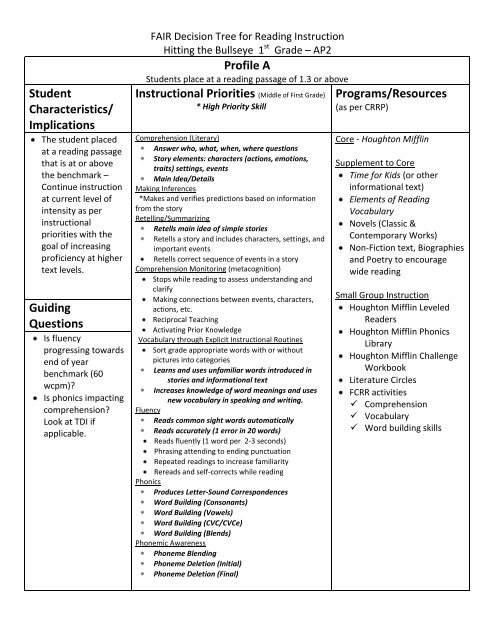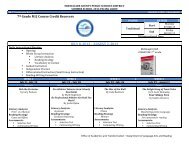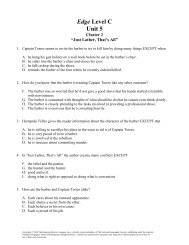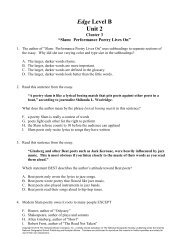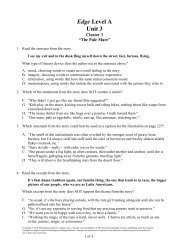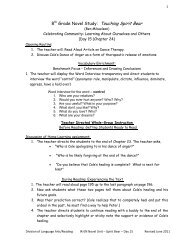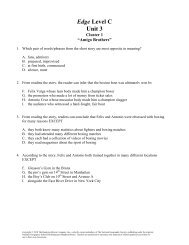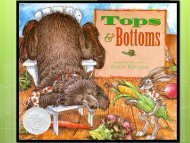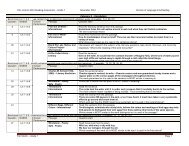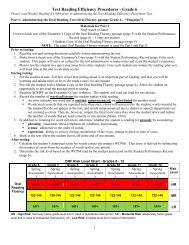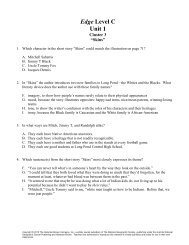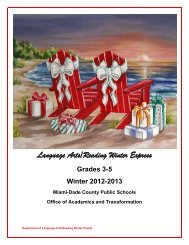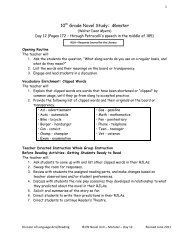Grade 1 Profiles - Division of Language Arts/Reading
Grade 1 Profiles - Division of Language Arts/Reading
Grade 1 Profiles - Division of Language Arts/Reading
Create successful ePaper yourself
Turn your PDF publications into a flip-book with our unique Google optimized e-Paper software.
Student<br />
Characteristics/<br />
Implications<br />
The student placed<br />
at a reading passage<br />
that is at or above<br />
the benchmark –<br />
Continue instruction<br />
at current level <strong>of</strong><br />
intensity as per<br />
instructional<br />
priorities with the<br />
goal <strong>of</strong> increasing<br />
pr<strong>of</strong>iciency at higher<br />
text levels.<br />
Guiding<br />
Questions<br />
Is fluency<br />
progressing towards<br />
end <strong>of</strong> year<br />
benchmark (60<br />
wcpm)?<br />
Is phonics impacting<br />
comprehension?<br />
Look at TDI if<br />
applicable.<br />
FAIR Decision Tree for <strong>Reading</strong> Instruction<br />
Hitting the Bullseye 1 st <strong>Grade</strong> – AP2<br />
Pr<strong>of</strong>ile A<br />
Students place at a reading passage <strong>of</strong> 1.3 or above<br />
Instructional Priorities (Middle <strong>of</strong> First <strong>Grade</strong>) Programs/Resources<br />
* High Priority Skill<br />
(as per CRRP)<br />
Comprehension (Literary)<br />
Answer who, what, when, where questions<br />
Story elements: characters (actions, emotions,<br />
traits) settings, events<br />
Main Idea/Details<br />
Making Inferences<br />
*Makes and verifies predictions based on information<br />
from the story<br />
Retelling/Summarizing<br />
Retells main idea <strong>of</strong> simple stories<br />
Retells a story and includes characters, settings, and<br />
important events<br />
Retells correct sequence <strong>of</strong> events in a story<br />
Comprehension Monitoring (metacognition)<br />
Stops while reading to assess understanding and<br />
clarify<br />
Making connections between events, characters,<br />
actions, etc.<br />
Reciprocal Teaching<br />
Activating Prior Knowledge<br />
Vocabulary through Explicit Instructional Routines<br />
Sort grade appropriate words with or without<br />
pictures into categories<br />
Learns and uses unfamiliar words introduced in<br />
stories and informational text<br />
Increases knowledge <strong>of</strong> word meanings and uses<br />
new vocabulary in speaking and writing.<br />
Fluency<br />
Reads common sight words automatically<br />
Reads accurately (1 error in 20 words)<br />
Reads fluently (1 word per 2-3 seconds)<br />
Phrasing attending to ending punctuation<br />
Repeated readings to increase familiarity<br />
Rereads and self-corrects while reading<br />
Phonics<br />
Produces Letter-Sound Correspondences<br />
Word Building (Consonants)<br />
Word Building (Vowels)<br />
Word Building (CVC/CVCe)<br />
Word Building (Blends)<br />
Phonemic Awareness<br />
Phoneme Blending<br />
Phoneme Deletion (Initial)<br />
Phoneme Deletion (Final)<br />
Core - Houghton Mifflin<br />
Supplement to Core<br />
Time for Kids (or other<br />
informational text)<br />
Elements <strong>of</strong> <strong>Reading</strong><br />
Vocabulary<br />
Novels (Classic &<br />
Contemporary Works)<br />
Non-Fiction text, Biographies<br />
and Poetry to encourage<br />
wide reading<br />
Small Group Instruction<br />
Houghton Mifflin Leveled<br />
Readers<br />
Houghton Mifflin Phonics<br />
Library<br />
Houghton Mifflin Challenge<br />
Workbook<br />
Literature Circles<br />
FCRR activities<br />
Comprehension<br />
Vocabulary<br />
Word building skills
Student<br />
Characteristics/<br />
Implications<br />
The student placed<br />
at a reading passage<br />
below benchmark<br />
(beginning first<br />
grade) - Provide<br />
explicit<br />
comprehension<br />
instruction as per<br />
instructional<br />
priorities with the<br />
goal <strong>of</strong> increasing<br />
pr<strong>of</strong>iciency at higher<br />
text levels.<br />
Guiding<br />
Questions<br />
Is fluency<br />
progressing towards<br />
end <strong>of</strong> year<br />
benchmark (60<br />
wcpm)?<br />
Is phonics a<br />
problem? Look at the<br />
TDI Word Building<br />
tasks. Provide explicit<br />
instruction in phonics<br />
from where the<br />
student scored BE. (If<br />
phonemic awareness<br />
is a deficiency revisit<br />
phoneme deletion<br />
tasks)<br />
FAIR Decision Tree for <strong>Reading</strong> Instruction<br />
Hitting the Bullseye 1 st <strong>Grade</strong> – AP2<br />
Pr<strong>of</strong>ile B<br />
Students place at a reading passage <strong>of</strong> 1.1 or 1.2<br />
Instructional Priorities (beginning <strong>of</strong> 1 st <strong>Grade</strong>) Programs/Resources<br />
* High Priority Skill<br />
(as per CRRP)<br />
Comprehension (Literary)<br />
Answer who, what, when, where questions<br />
Story elements: characters (actions, emotions, traits)<br />
settings, events<br />
Main Idea/Details<br />
Retelling/Summarizing<br />
Retells main idea <strong>of</strong> simple stories<br />
Retells correct sequence <strong>of</strong> events in a story<br />
Comprehension Monitoring (metacognition)<br />
Stops while reading to assess understanding and clarify<br />
Making connections between events, characters,<br />
actions, etc.<br />
Reciprocal Teaching<br />
Activating Prior Knowledge<br />
Vocabulary through Explicit Instructional Routines<br />
Sort grade appropriate words with or without pictures<br />
into categories<br />
Learns and uses unfamiliar words introduced in<br />
stories and informational text<br />
Increases knowledge <strong>of</strong> word meanings and uses new<br />
vocabulary in speaking and writing.<br />
Fluency<br />
Reads common sight words automatically<br />
Reads accurately (1 error in 20 words)<br />
Reads fluently (1 word per 2-3 seconds)<br />
Phrasing attending to ending punctuation<br />
Repeated readings to increase familiarity<br />
Rereads and self-corrects while reading<br />
Phonics<br />
Produces Letter-Sound Correspondences<br />
Word Building (Consonants)<br />
Word Building (Vowels)<br />
Word Building (CVC/CVCe)<br />
Word Building (Blends)<br />
Phonemic Awareness<br />
Phoneme Blending<br />
Phoneme Deletion (Initial)<br />
Phoneme Deletion (Final)<br />
Core - Houghton Mifflin<br />
Supplement to Core<br />
Time for Kids (or other<br />
informational text)<br />
Elements <strong>of</strong> <strong>Reading</strong><br />
Vocabulary<br />
Novels (Classic &<br />
Contemporary Works)<br />
Non-fiction text,<br />
Biographies and Poetry to<br />
encourage wide reading<br />
Small Group Instruction<br />
Houghton Mifflin Phonics<br />
Readers<br />
Houghton Mifflin<br />
Vocabulary Readers<br />
Words their Way<br />
Making Words (text and<br />
manipulatives)<br />
Audio Books<br />
FCRR activities<br />
Phonics<br />
Phonological<br />
Awareness<br />
Word building skills<br />
Intervention (if feasible)<br />
Voyager
FAIR Decision Tree for <strong>Reading</strong> Instruction<br />
Hitting the Bullseye 1 st <strong>Grade</strong> – AP2<br />
Pr<strong>of</strong>ile C<br />
Students placed at Listening Comprehension and TDI tasks fell in the Word Building range<br />
Student<br />
Characteristics/<br />
Implications<br />
The student placed in<br />
listening<br />
comprehension<br />
(Kindergarten Level) -<br />
Continue to build<br />
comprehension<br />
strategies moving<br />
from listening to<br />
reading<br />
comprehension at<br />
the word, sentence<br />
and paragraph level<br />
The student placed in<br />
the Word Building<br />
range <strong>of</strong> TDI tasks<br />
Guiding<br />
Questions<br />
Is phonics a<br />
problem? Look at the<br />
Word Building TDI<br />
tasks. Provide explicit<br />
instruction in phonics<br />
moving toward<br />
connected text.<br />
Instructional Priorities (Beg- Mid Kindergarten)<br />
* High Priority Skill<br />
Comprehension<br />
Identifying Information from Stories<br />
Answer who, where and what questions after listening<br />
to a sentence or short paragraph<br />
Responds to stories by answering and asking questions,<br />
discussing ideas, and relating events to personal<br />
experiences<br />
Uses pictures and information about the story to predict<br />
what will happen next.<br />
Retelling and Summarizing<br />
Retells a familiar story with a book<br />
Retells a familiar story without a book including<br />
beginning, middle, and end<br />
Making Connections<br />
Connects events, characters, and actions in the story to<br />
specific life experiences<br />
Vocabulary<br />
Names pictures <strong>of</strong> common concepts<br />
Uses words to describe location, size, color and shape<br />
Uses names and labels <strong>of</strong> basic concepts<br />
Identifies and sorts pictures <strong>of</strong> common words into basic<br />
categories<br />
Learns new vocabulary through stories and instruction<br />
Uses newly learned vocabulary on multiple occasions to<br />
reinforce meaning<br />
Fluency<br />
High Frequency Words<br />
High Frequency Word Phrases<br />
Recognizes some words by sight<br />
Phonics<br />
Produces Letter-Sound Correspondences<br />
Word Building (Consonants)<br />
Word Building (Vowels)<br />
Word Building (CVC/CVCe)<br />
Word Building (Blends)<br />
Multisyllabic Word <strong>Reading</strong><br />
Phonemic Awareness<br />
Phoneme Blending<br />
Phoneme Deletion (Initial)<br />
Phoneme Deletion (Final)<br />
Programs/Resources<br />
(as per CRRP)<br />
Core - Houghton Mifflin<br />
Supplement to Core<br />
Time for Kids (or other<br />
informational text)<br />
Elements <strong>of</strong> <strong>Reading</strong><br />
Vocabulary<br />
Novels (Classic &<br />
Contemporary Works)<br />
Non-Fiction text,<br />
Biographies and Poetry<br />
to encourage wide<br />
reading<br />
Small Group Instruction<br />
Houghton Mifflin<br />
Vocabulary Readers<br />
Houghton Mifflin Phonics<br />
Library<br />
Houghton Mifflin Extra<br />
Support Handbook<br />
Words their Way<br />
Making Words (text and<br />
manipulatives)<br />
Audio Books<br />
FCRR activities<br />
Phonics<br />
Phonological<br />
Awareness<br />
Intervention<br />
Voyager
FAIR Decision Tree for <strong>Reading</strong> Instruction<br />
Hitting the Bullseye 1 st <strong>Grade</strong> – AP2<br />
Pr<strong>of</strong>ile D<br />
Students placed at Listening Comprehension and TDI tasks fell in the phonemic awareness range or<br />
Letter Naming/Sound stage.<br />
Student<br />
Characteristics/<br />
Implications<br />
The student placed in<br />
listening<br />
comprehension<br />
(Kindergarten Level) -<br />
Continue to build<br />
comprehension<br />
strategies moving<br />
from listening to<br />
reading<br />
comprehension at<br />
the word, sentence<br />
and paragraph level<br />
The student placed in<br />
the Phonemic<br />
Awareness Range<br />
and/or Letter<br />
Naming/Letter<br />
Sounds TDI Task<br />
Guiding<br />
Questions<br />
Is knowledge <strong>of</strong><br />
letters and letter<br />
sounds a problem?<br />
Look at the Letter<br />
Naming & Sound<br />
Knowledge TDI task.<br />
Provide explicit<br />
instruction in letter<br />
names and letter<br />
sound<br />
correspondences<br />
moving toward<br />
phonemic awareness<br />
and word building<br />
tasks.<br />
Instructional Priorities (Beginning Kindergarten)<br />
* High Priority Skill<br />
Comprehension<br />
Identifying Information from Stories<br />
Answer who, where and what questions after listening<br />
to a sentence or short paragraph<br />
Responds to stories by answering and asking questions,<br />
discussing ideas, and relating events to personal<br />
experiences<br />
Uses pictures and information about the story to predict<br />
what will happen next.<br />
Retelling and Summarizing<br />
Retells a familiar story with a book<br />
Retells a familiar story without a book including<br />
beginning, middle, and end<br />
Making Connections<br />
Connects events, characters, and actions in the story to<br />
specific life experiences<br />
Vocabulary<br />
Names pictures <strong>of</strong> common concepts<br />
Uses words to describe location, size, color and shape<br />
Uses names and labels <strong>of</strong> basic concepts<br />
Identifies and sorts pictures <strong>of</strong> common words into basic<br />
categories<br />
Learns new vocabulary through stories and instruction<br />
Uses newly learned vocabulary on multiple occasions to<br />
reinforce meaning<br />
Fluency<br />
High Frequency Words<br />
High Frequency Word Phrases<br />
Recognizes some words by sight<br />
Phonics<br />
Produces Letter-Sound Correspondences<br />
Word Building (Consonants)<br />
Word Building (Vowels)<br />
Word Building (CVC/CVCe)<br />
Word Building (Blends)<br />
Multisyllabic Word <strong>Reading</strong><br />
Phonemic Awareness<br />
Phoneme Blending<br />
Phoneme Deletion (Initial)<br />
Phoneme Deletion (Final)<br />
Programs/Resources<br />
(as per CRRP)<br />
Core - Houghton Mifflin<br />
Supplement to Core<br />
Time for Kids (or other<br />
informational text)<br />
Elements <strong>of</strong> <strong>Reading</strong><br />
Vocabulary<br />
Decodable Text<br />
Small Group Instruction<br />
Houghton Mifflin Phonics<br />
Library<br />
Houghton Mifflin Extra<br />
Support Handbook<br />
Words their Way<br />
Making Words (text and<br />
manipulatives)<br />
Audio Books<br />
FCRR activities<br />
Phonics<br />
Phonological<br />
Awareness<br />
Intervention<br />
Voyager


